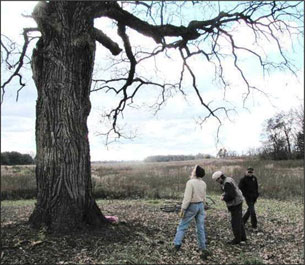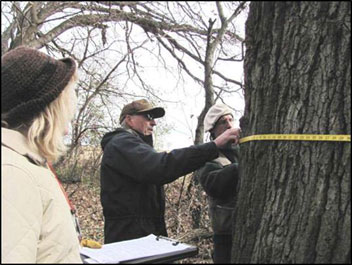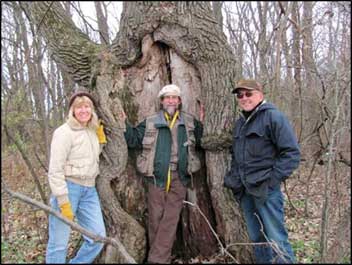
Heritage Oaks

As the oldest residents of McHenry County, old oak trees connect us to a time before McHenry County existed – before the State of Illinois was established – in some cases, before the Declaration of Independence was written!

Their gnarled limbs give oaks a unique character that draws people to them. The old oaks seem to have personalities – a bur oak with its arms spread wide can seem like an old friend, reliable and comforting, there when you need her.
TLC’s Oak Keeper project has identified many large, old oaks in the county. But, we know there are more ancient sentinels, and we would like to document them, and perhaps share their stories. Maybe even the story of the family that happens to have the oldest oak growing on their land.
Take Dr. Lloyd Shaw, for example. The property he owns along the Nippersink Creek north of Woodstock is home to many old oaks and hickories. As busy as he is with his veterinary practice, he still finds time to visit the property and clear buckthorn from around the oaks to keep them healthy. Lloyd grew up on the farm here, so this land is home. Spring wildflowers like trillium and jack-in-the-pulpit still dot the woodland floor. But like many of our woods, the absence of  grazing and fire has allowed exotic species like buckthorn and honeysuckle to shade out the understory wildflowers, and make oak regeneration impossible. Over the years, Dr. Shaw has seen the once open and inviting woodland become dark and crowded with underbrush, and he wanted to do something about it.
grazing and fire has allowed exotic species like buckthorn and honeysuckle to shade out the understory wildflowers, and make oak regeneration impossible. Over the years, Dr. Shaw has seen the once open and inviting woodland become dark and crowded with underbrush, and he wanted to do something about it.
Dr. Shaw heard about the Oak Keepers and was interested in having them come out, survey his woods and give him advice on management. Oak Keepers Greg Rajsky and Linda Burkart found mostly bur oaks, a lot of shagbark hickories and some hackberries. Among the bur oaks were several old-timers, including one measured at 50″ dbh (diameter at breast height), which translates to well over 300 years old. There may even be a witness tree (trees marked by surveyors in the 1830s to locate section lines) still standing!